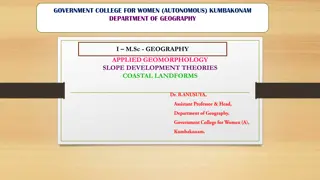Sustainable Construction of Coastal Facilities with Beach Sand & Brackish Water in Concrete
Explore a sustainable approach to constructing coastal facilities by incorporating beach sand and brackish water in concrete production. This method aims to address environmental concerns, reduce reliance on non-renewable resources like sand, and enhance the durability of structures. The project investigates the utilization of alternative materials and non-metallic reinforcements to promote eco-friendly construction practices.
Uploaded on Sep 26, 2024 | 2 Views
Download Presentation

Please find below an Image/Link to download the presentation.
The content on the website is provided AS IS for your information and personal use only. It may not be sold, licensed, or shared on other websites without obtaining consent from the author.If you encounter any issues during the download, it is possible that the publisher has removed the file from their server.
You are allowed to download the files provided on this website for personal or commercial use, subject to the condition that they are used lawfully. All files are the property of their respective owners.
The content on the website is provided AS IS for your information and personal use only. It may not be sold, licensed, or shared on other websites without obtaining consent from the author.
E N D
Presentation Transcript
A SUSTAINABLE APPROACH TO THE CONSTRUCTION OF COASTAL FACILITIES THROUGH THE INCORPORATION OF BEACH SAND & BRACKISH WATER IN CONCRETE PRODUCTION Imran H.R. Khan, Daniel White, Jenelle Mieux Foundations & Prior Learning Physics Unit, The University of Trinidad & Tobago Project Management and Civil Infrastructure Systems, The University of Trinidad & Tobago IConETech-2020, Faculty of Engineering, The UWI, St. Augustine, Trinidad and Tobago
INTRODUCTION WHY? T&T is listed as a water stressed nation. Sand is non-renewable resource, and alternative sources must be continually identified. On-site re-use of excavated material has a positive environmental impact when compared to mined materials. The inherent durability of polymeric reinforcements can increase the lifespan of structures in chemically aggressive environments. IConETech-2020, Faculty of Engineering, The UWI, St. Augustine, Trinidad and Tobago
OBJECTIVES Examine the prospects of utilizing beach sand and brackish water in concrete production. Initiate open discourse on the use of non-metallic reinforcement in concrete structures. IConETech-2020, Faculty of Engineering, The UWI, St. Augustine, Trinidad and Tobago
METHODOLOGY CEMENT CEMENT CEMENT CEMENT CEMENT CEMENT CEMENT CEMENT CEMENT CEMENT CEMENT Water : Cement 0.37, 0.39, 0.43, 0.45 0.37, 0.39, 0.43, 0.45 0.37, 0.39, 0.43, 0.45 0.37, 0.39, 0.43, 0.45 0.37, 0.39, 0.43, 0.45 0.37, 0.39, 0.43, 0.45 0.37, 0.39, 0.43, 0.45 0.37, 0.39, 0.43, 0.45 0.37, 0.39, 0.43, 0.45 0.37, 0.39, 0.43, 0.45 0.37, 0.39, 0.43, 0.45 0.37, 0.39, 0.43, 0.45 CEMENT Water : Cement Water : Cement Water : Cement Water : Cement Water : Cement Water : Cement Water : Cement Water : Cement Water : Cement Water : Cement Water : Cement Concreting Sand Concreting Sand Concreting Sand Concreting Sand Concreting Sand Concreting Sand Fine Aggregate Fine Aggregate Fine Aggregate Fine Aggregate Fine Aggregate Fine Aggregate Beach Sand Beach Sand Beach Sand Beach Sand Beach Sand Beach Sand Course Aggregate Course Aggregate Course Aggregate Course Aggregate Course Aggregate Course Aggregate Fresh Water Fresh Water Fresh Water Fresh Water Fresh Water Fresh Water Water Water Water Water Water Water Brackish Water Brackish Water Brackish Water Brackish Water Brackish Water Brackish Water Concrete [CFB] Concrete [CFF] Concrete [CFB] Concrete [BFB] Concrete [CBB] Concrete [BBB] Curing Curing Curing Curing Curing Curing IConETech-2020, Faculty of Engineering, The UWI, St. Augustine, Trinidad and Tobago
METHODOLOGY Testing of the Aggregate Organic Content Sieve analysis Testing of the Water Testing Salinity Chemical analysis Setting Times Compression Testing IConETech-2020, Faculty of Engineering, The UWI, St. Augustine, Trinidad and Tobago
RESULTS Testing of the Aggregate The organic content of the fine aggregates fell within acceptable limits, i.e. 1 to 3. Organic Content Sieve analysis Testing FM (concreting sand): 2.7 FM (beach sand as collected): 1.9 FM (beach sand as utilized): 2.6 Fig. 2. Concreting Sand Fig. 3. Beach Sand IConETech-2020, Faculty of Engineering, The UWI, St. Augustine, Trinidad and Tobago
RESULTS Testing of Water Brackish Water 5.65 ppt Salinity Chemical analysis (0.5 35 ppt) Testing Table 1 of mixing water used [SO4]2- 8 [Na]+ [K]+ [Mg]2+ Ions Fresh Water [ppm] Brackish Water [ppm] 26 6 6 79 106 5 5 IConETech-2020, Faculty of Engineering, The UWI, St. Augustine, Trinidad and Tobago
RESULTS Setting Times Table 2 Vicat Needle Setting Times for cement mixed with fresh water and cement mixed with brackish water Testing Initial Set Time [mins] Final Set Time [mins] Fresh Water 125 200 Brackish Water 120 205 IConETech-2020, Faculty of Engineering, The UWI, St. Augustine, Trinidad and Tobago
RESULTS Compression Testing Testing Figure 4: Graph of compressive strength vs water to cement ratio after 7-days. IConETech-2020, Faculty of Engineering, The UWI, St. Augustine, Trinidad and Tobago
RESULTS Compression Testing Testing Figure 4: Graph of compressive strength vs water to cement ratio after 28-days. IConETech-2020, Faculty of Engineering, The UWI, St. Augustine, Trinidad and Tobago
RESULTS Compression Testing Testing Figure 5: Graph of compressive strength vs water to cement ratio after 42-days. IConETech-2020, Faculty of Engineering, The UWI, St. Augustine, Trinidad and Tobago
CONCLUSIONS Fine aggregate is a non-renewable resource essential to many industrial sectors Evaluation of possible sources for applicability is necessary Fineness Modulus may have to be adjusted Beach sand produces stronger concrete with brackish water; however, off-shore sand may be superior Coastal construction projects are ideally suited to make use of the excavation spoil IConETech-2020, Faculty of Engineering, The UWI, St. Augustine, Trinidad and Tobago
CONCLUSIONS Special permissions may be required to excavate beach sand The use of brackish water in concrete production lessens the impact concrete production would have in water stressed areas Long-term investigations are required to investigate the durability of concrete: produced with newer materials from exposure to seawater IConETech-2020, Faculty of Engineering, The UWI, St. Augustine, Trinidad and Tobago
REFERENCES 1. Ewing_Chow, D. (n.d.). In Search Of A Solution For Water Scarcity In The Caribbean. Retrieved from https://www.forbes.com/sites/abb/2019/12/19/maritimes-next- wave-an-ancient-industrys-bold-new-thinking/#665dfcb3552d 2. M. K. Boodhan, Renewable energy powered desalination in SIDS- opportunities and challenges in the Caribbean Region, 3. R. Mahendran, K. Godwin, T. Gnana Selvan and M. Murugan. Experimental Study On Concrete Using Sea Sand As Fine Aggregate. International Journal of Scientific & Engineering Research, 7 no. 5, (2016) 49-52 IConETech-2020, Faculty of Engineering, The UWI, St. Augustine, Trinidad and Tobago
THANK YOU! IConETech-2020, Faculty of Engineering, The UWI, St. Augustine, Trinidad and Tobago























